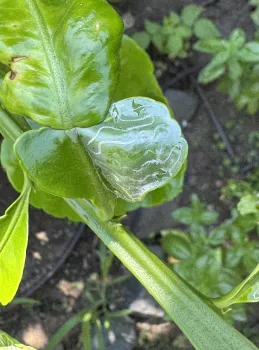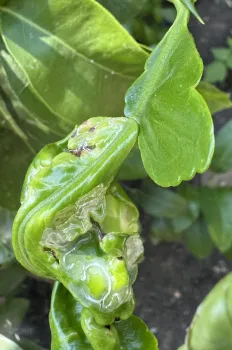
Article and photos by Peg Smith -
On a wander through the garden, I noticed this whimsical pattern on the new growth of the grapefruit tree caused by the larvae of the Citrus Leafminer Moth, a native of Asia and a relative newcomer affecting California’s citrus industry. First detected in Imperial County in 2000, the moths have gradually moved north through California. The photos show early leaf damage and more advanced leaf damage. Surprisingly, despite the leaf damage this is one of those times when less action combined with timely action are the best choice rather than a pesticide solution.
The life cycle of the Citrus Leafminer Moth follows a typical pattern. The moth is about ¼ inch long and is light colored with black spots at each wing tip. The female lays single eggs on the underside of the fresh young growth of citrus trees. After hatching, the larvae begin to ‘mine’ just below the surface of the leaf as they feed. The leaves show the mining patterns and begin to curl. The larvae molt four times, the ‘trails’ they leave can appear darker as the larvae deposits its frass (feces) while moving through the leaf. When the larva is ready to pupate, it emerges from the leaf and rolls the edge of the leaf into a curl, attaches, and becomes a pupa. The life cycle is about three to seven weeks.
What’s the best way to manage leaf miners?
Leafminers are only able to feed on young growth. Older citrus leaves have become hardened and will not be affected by the leafminer larvae.

When citrus trees are pruned, a flush of new growth can occur. The best gardening practice for citrus is to prune once a year after fruiting for shape, removing dead wood, crossing branches, and improving airflow. This will mean that the trees' push of new growth will occur predominantly at one time. If the tree is pruned multiple times, it provides more occasions for leafminer infestations. It is not necessary to prune off affected leaves, as the remaining leaf tissue will continue to produce nourishment for the tree from the unaffected leaf parts. Mature citrus will not be adversely affected by some leafminer damage on new growth. Young citrus trees push more fresh growth, so they are more susceptible to damage.
Avoid applying nitrogen fertilizer when citrus are developing new leaves and growth, as this is when leafminer presence is more likely. The nitrogen feeding will encourage more young growth. Instead, fertilize citrus when new growth has matured somewhat and is more resistant to leafminer larvae penetration.
Insecticides
The general insecticides available are not effective for leafminer larvae as they do not penetrate the leaves and are likely to leave deposits that will kill the natural enemies, such as the parasitic wasps that lay their eggs inside the trails. When the parasitic wasp larvae emerge, they consume the leafminer larvae.
Traps
There are available baited pheromone traps specific to leafminer moths that will attract only the male moths. In a mature tree, these should be hung at about shoulder height and then monitored to replenish the bait when needed. These traps will not control the population, but will help reduce it.
Good garden husbandry will limit the effects of leafminer larvae, and we can tolerate a few imperfect leaves to give our citrus the best care.
For more information, see the article from UC Master Gardeners of Alameda County - Citrus Leafminer.

